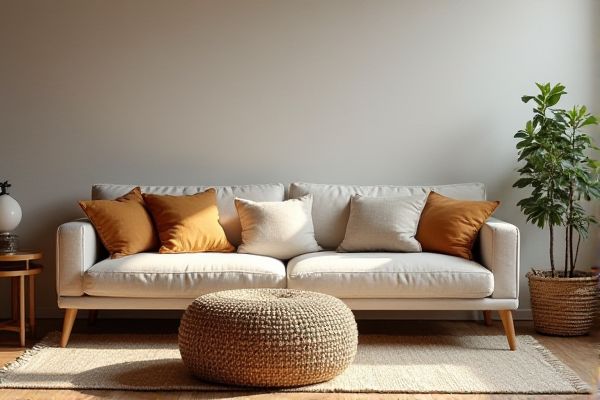
Ottomans and poufs both serve as versatile seating and footrest options, but ottomans typically feature a structured frame with storage space inside, while poufs are softer, unframed, and more portable. Understanding the key differences can help you choose the right piece to enhance Your living space; continue reading to explore their styles, uses, and benefits.
Table of Comparison
| Feature | Ottoman | Pouf |
|---|---|---|
| Design | Boxy, often with a hinged top or storage compartment | Round or cylindrical, soft and cushion-like |
| Function | Footrest, extra seating, or storage | Footrest or casual seating |
| Structure | Firm frame, upholstered with wood base | Soft and fully upholstered, no rigid frame |
| Size | Typically larger, can be used as a coffee table | Smaller, easy to move around |
| Style | Traditional to modern, often structured | Casual, bohemian or contemporary |
| Storage | Commonly includes hidden storage space | Rarely includes storage |
| Material | Leather, fabric, velvet; sturdy materials | Fabric, knitted, leather, often softer textiles |
Understanding Ottomans and Poufs: Key Differences
Ottomans typically feature a sturdy frame with storage capabilities, making them multifunctional furniture pieces ideal for living rooms. Poufs, in contrast, are lightweight, cushioned, and versatile seating options without internal storage, often used as footrests or casual stools. The key difference lies in their construction and purpose: ottomans provide support and storage, whereas poufs prioritize portability and comfort.
Historical Origins of Ottomans and Poufs
Ottomans originated in the Ottoman Empire during the late 18th century, serving as versatile seating or footstools often upholstered with rich fabrics reflecting Middle Eastern artistry. Poufs, rooted in Moroccan and North African traditions, feature a round, cushioned design crafted from leather or textured textiles, symbolizing casual comfort and handcrafted heritage. Your choice between an ottoman or pouf can enhance the cultural aesthetic and functional style of your living space.
Design and Styles: Ottoman vs Pouf
Ottomans often feature structured designs with built-in storage and traditional upholstery like leather or velvet, making them versatile for seating and decor. Poufs typically have a softer, more casual appearance with knitted, woven, or patterned fabrics, adding a cozy, bohemian touch to your space. Your choice between ottoman and pouf depends on whether you prefer a functional, classic look or a relaxed, decorative accent.
Material Choices: What Sets Them Apart
Ottomans typically feature sturdy frames made from wood, metal, or engineered board, often upholstered with leather, fabric, or velvet, offering durability and structured support. Poufs, on the other hand, favor softer materials such as knitted cotton, woven fabric, or leather without rigid framing, emphasizing a lightweight, flexible design. These material differences influence both the aesthetic and functional use, with ottomans providing solid seating or storage options, while poufs offer casual comfort and versatility.
Functional Uses: Storage, Seating, and More
Ottomans often feature hidden storage compartments, making them ideal for organizing blankets, magazines, or remote controls while doubling as comfortable seating. Poufs primarily serve as lightweight, portable seating options or footrests without built-in storage, offering flexibility in small spaces. Your choice depends on whether multifunctional storage combined with seating or simple, stylish seating is the priority.
Versatility in Home Decor
Ottomans and poufs both offer versatile options for home decor, seamlessly functioning as extra seating, footrests, or coffee tables depending on the space. Ottomans typically feature structured designs with storage capabilities, ideal for organizing living areas while enhancing comfort. Poufs provide a more casual, lightweight aesthetic, easily moved around to add texture and color to various rooms.
Comfort Comparison: Ottoman vs Pouf
Ottomans provide superior comfort due to their structured padding and firmer support, making them ideal for extended seating or footrest use. Poufs offer a softer, more flexible feel with their cushioned, often filled interiors, better suited for casual lounging or light footrest purposes. Your choice depends on whether you prioritize firm support or a cozy, adaptable seating option.
Space Considerations: Which Fits Your Room?
Ottoman and pouf designs differ significantly in size and shape, influencing space considerations in your room. Ottomans typically offer a larger footprint with built-in storage options, making them ideal for spacious living areas that require multifunctional furniture. Poufs, being smaller and more flexible, are perfect for compact spaces or as supplementary seating without overwhelming your room's layout.
Maintenance and Durability Factors
Ottomans typically feature sturdy wooden or metal frames with high-density foam cushions, offering enhanced durability and ease of maintenance through simple fabric cleaning or cushion replacement. Poufs, often made from knit, leather, or woven materials, require more delicate care to prevent wear and tear, making them less resistant to heavy use. Your choice should consider the ottoman's long-lasting construction for frequent use or the pouf's aesthetic appeal with lighter maintenance demands.
Choosing Between Ottoman and Pouf: Which Is Right for You?
When choosing between an ottoman and a pouf, consider the functionality and style that best fit your space. Ottomans typically offer storage options and structured seating, making them ideal for organized living rooms or bedrooms. Poufs provide flexible, casual seating with lightweight portability, perfect for informal areas or adding a cozy, bohemian touch.
 homyna.com
homyna.com